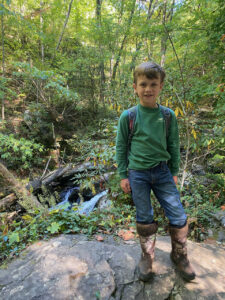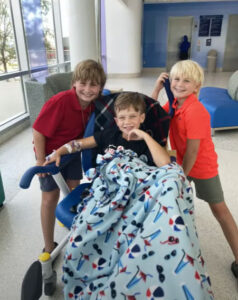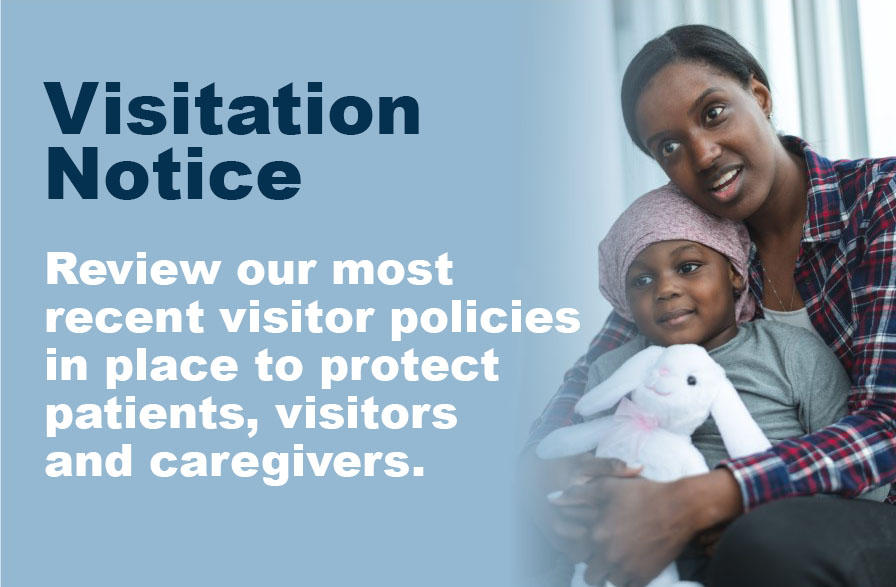
 Brittain’s Brush with Danger
Brittain’s Brush with Danger
Brittain Shell is an active 9-year-old boy who loves playing baseball and exploring the outdoors with his family and friends. But one summer afternoon just before his ninth birthday, all of that came to a halt.
July 23, 2023, began as a regular Sunday for the Shell family. Brittain’s parents, Katie and Jared, and his two younger siblings went to church and enjoyed a family lunch. Brittain was excited to play outside with his friends that afternoon. But while he was at his friend’s house, Katie and Jared got a call no parent could ever dream of receiving.
“Brittain’s friend’s dad called me and said, ‘This is not a good phone call. Brittain was bitten by a snake, and he’s being rushed to the hospital,’” Jared says.
With snake bites, time is of the essence. Brittain’s friend’s mom immediately took him to the local hospital, where Jared met them. But it was quickly determined that he needed a higher level of care. With his dad by his side, he was transferred by ambulance to Atrium Health Levine Children’s Beverly Knight Olson Children’s Hospital at Atrium Health Navicent in Macon, Georgia.
Meanwhile, Katie and her dad were on their way to Macon, which is about 30 minutes from their home. An ambulance passed them as they were driving on the interstate. They knew it was carrying Brittain to the hospital.
“Knowing my son was in an ambulance right beside me … I lost it. I felt so helpless,” Katie says.
They didn’t know it at the time, but their son was in anaphylactic shock in response to the snake’s venom.
Lifesaving treatment
Dr. Jacob Kirkpatrick, assistant medical director at Beverly Knight Olson Children’s Hospital, treated Brittain when he arrived.
“Some of our initial observations of Brittain were that he had a lot of upper airway swelling, which was causing him to struggle to breathe,” Kirkpatrick says. “He was also lethargic – not as responsive as we would have liked. And his blood pressure was dangerously low. It was pretty worrisome.”
Jared and Katie, both of whom have a medical background, asked questions and communicated with Kirkpatrick and the team about Brittain’s status. But that didn’t fully prepare Katie for when she first saw Brittain in the hospital bed.
“I walked in and noticed that he was pale,” Katie says. “He looked really sick and was moaning that he couldn’t breathe. The staff very calmly handled the urgency of the situation, and I stepped outside to try to collect myself. It was very difficult to see him like that.”
Once Brittain’s airway was secure and his blood pressure was more stable, the team started a dose of lifesaving antivenom, a medicine that works quickly to reverse the effects of the snake’s poison. He was then moved from the pediatric emergency room to the pediatric intensive care unit (PICU) at Beverly Knight Olson Children’s Hospital for further care and observation.
Dr. Joshua Glenn, director of pediatric surgery at Beverly Knight Olson Children’s Hospital, explains that in order to assess how Brittain’s body was responding to the antivenom, he used a small tool that monitors the pressure in the legs.
“We stick a needle into the leg, into the muscle layer, and get a measurement of the pressure in the legs,” Glenn says. “If the pressure is higher than a certain number, we worry that there’s too much pressure on the nerves that could cause lasting damage.”
At the time, Brittain’s pressure levels were still concerning. The plan was to place him on a ventilator and let the antivenom do it’s their work and monitor him along the way. All they could do now was wait.
 One step forward…
One step forward…
On his third day in the hospital, Brittain started to stir.
“He looked at me and mouthed around the ventilator tube: ‘I. Love. You.’,” Katie recalls. “Then he used his little hands and pulled me in for a hug. In that moment I just felt like he was going to be OK.”
Brittain had his breathing tube removed and began to wake up, but his care team noticed that his bite site was starting to worsen.
“There was more redness and swelling around the bite, so they said he would need another round of the antivenom,” Jared says.
Glenn says although they saw small improvements, it took several additional doses of antivenom before the swelling and pressure in his leg began to decrease. The care team was hopeful.
“It was very scary,” Katie says. “We didn’t know how he was going to respond to the additional doses … but he started to come back. We are just so grateful that there is a place that has all the resources and the desire to help. They saved our child’s life.”
The extra mile
Katie says one of things she wasn’t prepared for during Brittain’s healing process was when he was taken off the ventilator.
“Those were some of the hardest days in the hospital,” Katie says. “He was missing a big baseball tournament – he was an all-star and got picked for the team – and he was really disappointed and sad that he had to miss it. He was on a lot of medicine, including steroids, and he just wasn’t himself. It was very difficult to see him like that and not be able to do anything for him.”
Katie says this is where the child life program at Beverly Knight Olson Children’s Hospital, saved the day.
“She was so good with him,” Katie says. “When he was scared and confused, she gently asked him if he remembered what happened and how he got there.”
When Katie noticed that Brittain was picking at his hospital gown, a child life specialist jumped into action and got him a pair of shorts and an Atlanta Braves T-shirt (his favorite baseball team) to help him feel more comfortable. But perhaps the most meaningful milestone in Brittain’s healing journey was when she took him outside for the first time during his recovery.
“It was like a light switch flipped,” Katie says. “He said, ‘I can do this.’ It reminded him things are going to be OK and helped him turn on his game face and do his physical therapy so he could go home.”
Katie says she never fully appreciated the impact a child life specialist can have on a child’s experience in the hospital.
“They were the light in a really dark time,” Katie says. “They immediately saw him as a person and not just a patient. They got on his level and made him feel more comfortable. When you’re 8 years old, that stuff really matters.”
Beyond the bite
 After being in the hospital for six days, Brittain was able to go home on July 28 – the day before his ninth birthday.
After being in the hospital for six days, Brittain was able to go home on July 28 – the day before his ninth birthday.
“Everyone genuinely cared about him and wanted to get him out before his birthday,” Katie says. “So when they wheeled him out … it was a really good feeling.”
Brittain keeps up with his physical therapy at home to strengthen the muscles on the outside of his ankle where he was bit. And he sleeps in a brace to keep his foot from dropping and help remind it of the proper positioning.
“He can roll his ankle easily,” Katie says. “There’s still some work to do to help him get back to his ‘normal’ running. But in true Brittain fashion, he has figured out how to run, walk and play baseball in his own way.”
From an emotional perspective, Brittain has had to work through some residual fears when he walks in tall grass or through the woods. But avoiding outdoor activities isn’t an option. The Shell family enjoys hunting, camping and fishing, so Katie says they have had to make it a point to not let this consume them – even though that’s easier said than done.
Katie adds that they continue to talk with Brittain about the accident to help him process what happened.
“We tell him that we can do all the things to try to keep us safe, but some things are just out of our control,” Katie says. “All we can do is try to enjoy life and rely on people to help us if we need it – like the entire medical staff at the hospital who helped him.”
To those who may find themselves in a similar circumstance – seeing their child in a terrifying situation and being overwhelmed that you’re not able to help – Katie says you are not alone.
“It’s hard to feel so helpless,” Katie says. “But just know you don’t have to be hopeless.”




